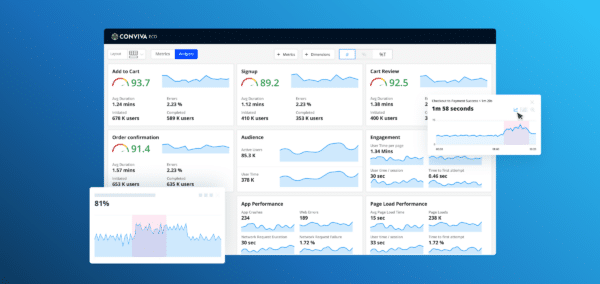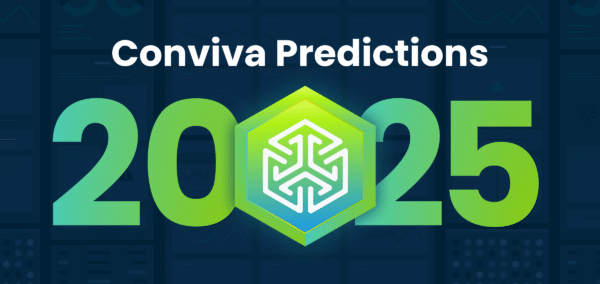
Where’s your audience going? If you’re doing things right, viewers are staying put.
Audience retention has two sides: tactical and strategic. On the ops level, you want to make sure your quality is high enough for viewers to stick with your streams in session. On the organizational level, you need insights that help you reduce churn.
Quality of experience is integral to both of these. With laggy, low-quality delivery, you’re going to keep losing viewers. Stateful, real-time, census-level experience measurement is the only way to optimize your user experience, creating loyal viewers and audiences.
Key takeaways:
-
- Streaming enterprises need quality data to inform how they prioritize improving in-session viewer retention.
- Total audience retention depends on more than just improving programming — QoE matters, too.
- You need scalable streaming analytics to drill down into every session in real-time and deliver true QoE improvements.
The Technical Metric: Viewer Retention Rates
Your viewer retention rate basically shows you how long people watch your videos. It’s usually not as important at the enterprise level as it is for amateur/independent publishers on video-sharing platforms — at least not on its own.
Obviously, you typically want people to watch content to the end. It means they’re interested in your programming.
In some business models, high retention also means that you can serve more ads. Regardless of the exact reason, having more minutes tends to be good for increasing revenue and lowering costs.
The issue here is that, as a regional or global publisher, you need to know exactly what’s happening when viewers decide to bail out on a video. Otherwise, you’re stuck making guesses as to the root cause of the abandonment.
Those guesses could drastically increase the cost of operating your service or result in further audience losses. You don’t want to guess; you need real data.
You need a stateful, census-based, real-time view of these types of events. That’s the only way you can:
-
- React in a timely manner to any service-based problems
- Prevent more viewers from leaving a stream due to technical issues
- Uncover patterns that reveal unlikely root causes (end-user device issues, CDN bugs, etc.)
- See these issues in the context of each viewer’s total journey, not just within the context of the video player’s reporting
Audience retention depends on every-minute, every-session analytics on big-data streams, especially at this lower, tactical level. And remember: You’re only going to be able to pursue your larger strategic objectives if you have a solid tactical foundation.
Retaining Viewers In-Session in Streaming Enterprises: Who Needs It the Most?
Some types of enterprises need the technical side of viewer retention more than others. There are a few factors that indicate you might want to focus on this.
Live Streaming
When your viewers leave during a sports live stream, you’re probably never going to see them again. It’s essential that you understand exactly why this is happening.
If all of the fans of a particular team quit your stream when it’s obvious their side has lost, that’s one thing. If viewers are abandoning your broadcast because of buffering or quality loss, that’s another thing entirely.
Even when you have exclusive streaming rights to an event, there are usually other options out there. People can usually turn to linear broadcast providers, for example. Who knows — if your stream is bad enough, maybe they’ll turn on the radio or just check the scores on social media.
Ad-Supported Video-on-Demand Models
You’re also going to want to retain viewers on the tactical level if you’re serving ads throughout longer content. Each time a viewer leaves before the next ad rolls, you’re losing out.
As more of the VoD world shifts toward ad-supported services or service tiers, viewer retention rates are going to increase in importance. However, lower retention rates might actually be a good thing if you serve mostly short videos — as long as it lets you serve more ads and doesn’t permanently lose audience members.
The point here is that, like any streaming metric, you should look at viewer retention rate in context to determine what it means for your business and your audience. That way, you know when, where, and for whom you need to prioritize optimizing it — or if you even need to work on it at all at this stage of your strategy.
Audience Retention as a Key Performance Indicator
While it might relate to your viewer retention rates, increasing your overall audience retention is much more complex. This is more of a KPI that shows you your progress toward business objectives, specifically revenue stabilization and growth.
Audience retention can involve various strategies for various businesses. Here are some examples:
-
- VoD service lowering base subscriber churn by expanding programming
- Sports-fan-heavy publisher stopping seasonal churn by securing licenses for year-round events
- Regional or national firms securing big-name license agreements
The problem here is that most of these strategies depend on programming. Programming matters, of course, but the best content in the world won’t matter if you can’t serve it at high quality with low costs.
The Challenge of Keeping Your Audience
More and more streaming consumers are patching together multiple services. They’re actively comparing your service with others, both inside and outside of your niche. After all, people have a budget and only have so many entertainment hours per day.
Add that to the increasing saturation of the market in general. Rather than fighting to get people to adopt the streaming model, you’re more likely to be fighting over a place in their subscription budget.
The good news is that you can differentiate based on QoE. That’s true regardless of your niche, business model, or region.
QoE is a major factor in whether people stay with your service. All you need to do to stay on top of it is use all of the data at your disposal.
You need a platform like Conviva to get insight into what QoE means for your audience. This type of real-time, census-based streaming analytics will help you:
-
- Uncover metrics that impact your KPIs the most
- Form measurable, closed-loop decision chains that improve performance
- Build operations optimizations roadmaps with clear, attainable goals
- Translate your overall vision into actionable guidelines
- Use real-time alerts to mitigate or prevent audience loss from service degradation
Cutting-Edge Audience Retention Tools
There’s a better way to improve QoE. Check out how to act on real-time data or click here to request a demo.






